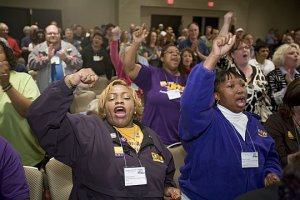Labor Notes Conference 2008: Enthusiasm and Inspiration

The labor movement has been hurtin’ for certain, so what made the Labor Notes conference April 11-13 in Detroit seem an oasis of enthusiasm and inspiration? It’s difficult to convey to those who weren’t there—especially since every two years, this magazine always brags about the terrific spirit shown at the conference.
It’s true, though, that this year’s event, with almost 1,100 participants, seemed to set a new standard. Many participants commented on the high level of no-holds-barred discussion about the crucial issues facing labor, such as how best to organize the unorganized (and do shortcuts work?).
Wrote self-described “jaded labor warhorse” Carol Lambiase, an international rep for the United Electrical Workers, “The carefully sponsored debates were the most interesting.
“I’ve always thought that the conference was a good thing for up-and-coming labor activists because of the skill-building sessions done from a rank-and-file perspective,” Lambiase said. “But for me, Labor Notes’ signature ability to define the critical debates of the day was the most invigorating and useful part.”
At the opposite end of the experience spectrum, first-time participant Joette Maschke, a Social Security claims rep from Bay City, Michigan, said, “Words can’t express how much the conference meant to me. I am a changed person. It was an eye-opener, very emotional and very moving.”




Why, as labor fights to maintain its ranks, did the conference grow? Close to 200 more people attended than came two years ago. One answer is that more people took it upon themselves to organize locally and come in groups, rather than as individuals.
WHY WAS IT BIGGER?
In the San Francisco Bay Area and Portland, for example, local support committees held fundraisers to bring large crews of young hotel workers and building trades apprentices. Volunteers and staff jammed phone lines in the Detroit office for weeks in nightly outreach efforts.
The bigger-picture answer is, “It was time.” Discussions had been simmering, and Detroit in April became the place to bring them to a head. For example:
• After two years of backlash since the great May Day immigrant rights marches of 2006, it was time to talk about re-mobilizing immigrant communities.
• After contract after contract of concessions on health care, it was time to thrash out how we were going win real health care reform.
• After decades of disconnection and hundreds of thousands of jobs transferred, it was time to talk about how North American unionists could relate to workers in China.
• With telecom workers falling by the thousands to restructuring, it was time to strategize for the Verizon contract and beyond.
• Though union democracy had been coolly dismissed by some big thinkers as irrelevant, relentless centralization placed that issue back on the table when a struggle broke out within the Service Employees International Union (SEIU).
RESPECTFUL DEBATE

SUPPORT LABOR NOTES
BECOME A MONTHLY DONOR
Give $10 a month or more and get our "Fight the Boss, Build the Union" T-shirt.
With one major exception, issues were thoughtfully and respectfully debated.
Participants gathered in 110 workshops and meetings with members of their own and other unions. When they weren’t debating big strategies, they learned nuts-and-bolts tactics (assertive grievance handling, running for office), created new networks, agreed, disagreed, and inspired each other.

India held captive at a Mississippi shipyard
tell their story.
Some highlights:
• About 250 participants swelled the picket lines at an ongoing auto workers strike against wage cuts at American Axle in Detroit. A half-dozen amazed American Axle workers later came to the conference to be presented with Labor Notes’ “Troublemaker” award.
• Telecom workers held a special half-day meeting to strategize over upcoming contract expirations and restructuring in their industry.
• Rail workers from seven unions founded Railroad Workers United, a cross-union solidarity caucus aiming to counter the frequent feuding and disunity among rail unions.
• A linked set of workshops on China drew new participants who debated how to relate to the world’s largest workforce.
• Another track on Black workers’ issues drew activists into a unique cross-union dialogue.
• A workshop titled “Neutrality Agreements and Organizing Deals: Salvation or Sell-Out?” drew more than 100 attendees to debate both principles and practical results.
• Participants came from 21 countries, including Vietnam, Sri Lanka, Cambodia, Mexico, Brazil, Costa Rica, Colombia, and China.

• A crew from the new reform movement within the SEIU, SMART, met veteran union democracy activists from other unions—Teamsters, UAW—who helped them strategize about their upcoming convention.
• A timeline exhibit of magazine covers and photos from Labor Notes’ 29-year history was startling for the movement’s old hands—were we ever that young? But veterans were outnumbered by first-time participants.
• “Troublemaker” awards were given to John Sferazo, an Ironworker and 9/11 responder who fought for compensation for workers disabled by their work at Ground Zero; the United Workers, a group of low-income workers who won a living wage for the day laborers who clean Camden Yards in Baltimore; the Taxi Workers Alliance, which organizes New York City’s immigrant cabbie workforce; and American Axle strikers.
Despite the specific tactics, friendships, and networks gained at such a conference, participants frequently commented on the “I’m not alone” moments.
Roland Day, of International Longshoremen’s Association Local 333 in Baltimore, said: “We’ve gone so long without solidarity. We can’t do it alone, and it’s great to know that someone else, somewhere else is fighting back, too.”
